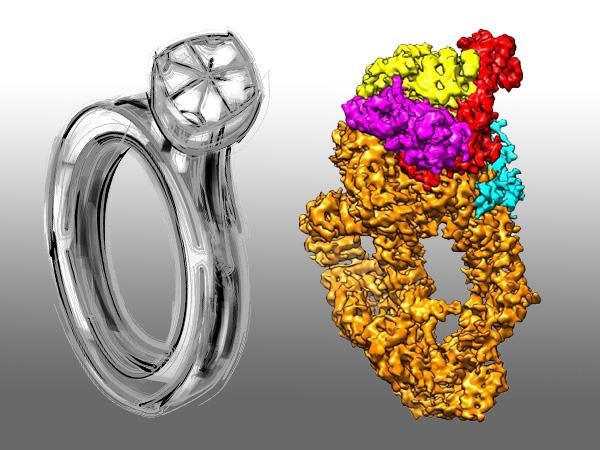USTC reports diamond ring architecture of a protein complex

The NuA4 cryo-EM structure is akin to a diamond ring. Credit: USTC News Center
NuA4/Tip60 is a complex which catalyzes diverse substrates critical for gene regulation, DNA repair, and cell cycle progression. Yet its compositional complexity and conformational flexibility have long impeded researchers from exploring at high precision.
By utilizing cryo-electron microscopy (cryo-EM), CAI Gang's team provides a high-resolution view of this complex in sub-nanometer scale, and discloses how NuA4/Tip60 assemblies for the first time.
The 4.7 Å resolution structure illuminates Tra1/TRRAP and Eaf1 serve as a scaffold for NuA4/TIP60 assembly. Although Tra1/TRRAP lacks of kinase catalytic activity, it adopts active conformation of the catalytic domain in NuA4/TIP60 assembly.
Besides providing more insights about scaffolding and regulatory mechanisms of Tra1/TRRAP, the structure elucidates more details about NuA4/TIP60 subunits.
Unexpectedly, the structure also shows human TRRAP mutations are largely centered on the Tra1/TRRAP interaction surfaces mediating NuA4/TIP60 assembly. Since Tra1/TRRAP contains hotspots for tumorous generation, this observation warrants preventing cancer by targeting the scaffolding function of TRRAP.
In addition, since Tip60 is significantly down-regulated in many cancers (i.e. breast and prostate), specific inhibitors of Tip60 will promise major breakthrough in cancer treatment.
Talking about future plans, CAI Gang will focus on obtaining structure of the holoenzyme and determining the substrate specificity and catalytic mechanism of NuA4/Tip60. These could greatly facilitate the development of specific TIP60 inhibitors and potent chemotherapeutic drugs, aiming at treating more people suffering from cancer.
Media Contact
All latest news from the category: Life Sciences and Chemistry
Articles and reports from the Life Sciences and chemistry area deal with applied and basic research into modern biology, chemistry and human medicine.
Valuable information can be found on a range of life sciences fields including bacteriology, biochemistry, bionics, bioinformatics, biophysics, biotechnology, genetics, geobotany, human biology, marine biology, microbiology, molecular biology, cellular biology, zoology, bioinorganic chemistry, microchemistry and environmental chemistry.
Newest articles

Properties of new materials for microchips
… can now be measured well. Reseachers of Delft University of Technology demonstrated measuring performance properties of ultrathin silicon membranes. Making ever smaller and more powerful chips requires new ultrathin…

Floating solar’s potential
… to support sustainable development by addressing climate, water, and energy goals holistically. A new study published this week in Nature Energy raises the potential for floating solar photovoltaics (FPV)…

Skyrmions move at record speeds
… a step towards the computing of the future. An international research team led by scientists from the CNRS1 has discovered that the magnetic nanobubbles2 known as skyrmions can be…





















